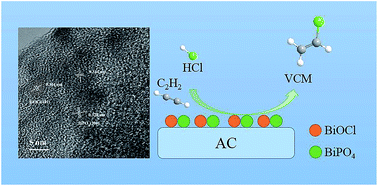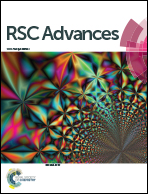Bi/AC modified with phosphoric acid as catalyst in the hydrochlorination of acetylene†
Abstract
A series of H3PO4-modified Bi/AC catalysts with different P/Bi ratios were prepared by an incipient wetness impregnation method for the acetylene hydrochlorination reaction. The C2H2 conversion reduced in the following sequence: BiP0.5/AC > BiP1/AC > Bi/AC > BiP0.1/AC > BiP2/AC > BiP3/AC. BiP0.5/AC exhibited highest catalytic activity, with 82% conversion of C2H2 and 92% selectivity for vinyl chloride, among the catalysts that were investigated. Characterization was carried out using N2 adsorption/desorption analysis, powder X-ray diffraction, transmission electron microscopy, thermogravimetric analysis, temperature-programmed reduction, atomic emission spectroscopy, and X-ray photoelectron spectroscopy. The results revealed that BiOCl was the main active species in the acetylene hydrochlorination reaction. The addition of H3PO4 promoted the dispersion of the Bi active component, strengthened the interaction between the metal and the support, and reduced the loss of the active component during the hydrochlorination of acetylene.



 Please wait while we load your content...
Please wait while we load your content...